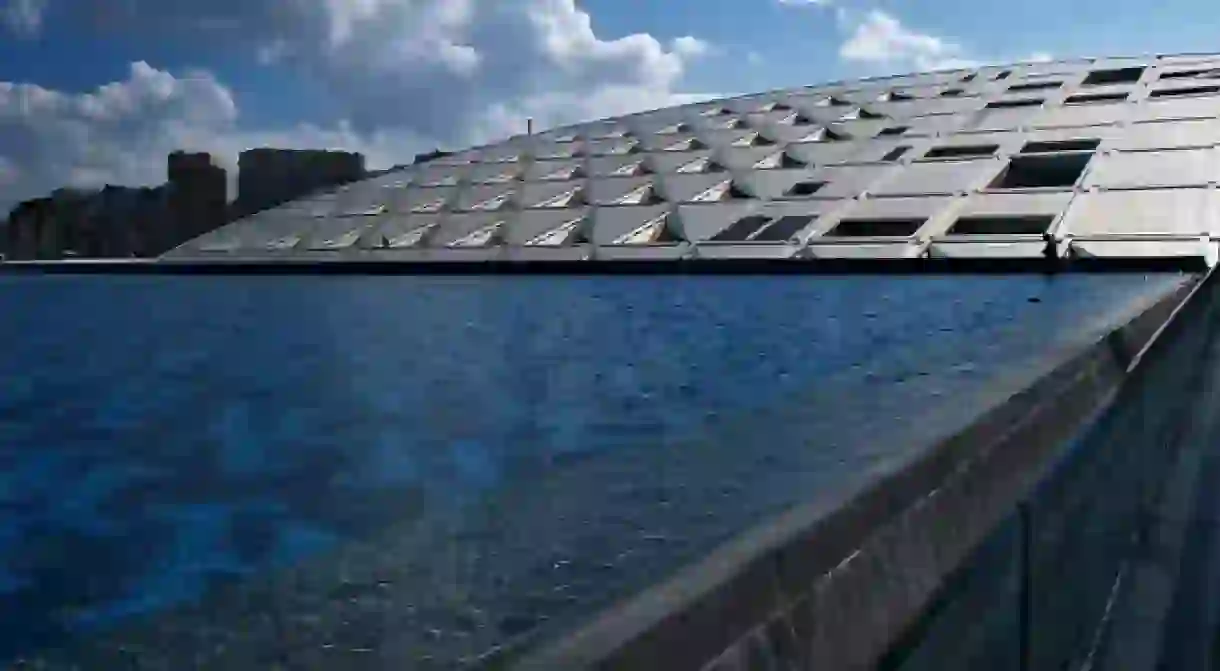Past And Present: The Bibliotheca Alexandrina

Egypt is in a state of flux and its creative juices are flowing. The Egyptian people are speaking their minds and making change happen. Sarah Zakzouk visits the Bibliotheca Alexandrina, the modern Library of Alexandria, and finds an impressive institution recapturing the spirit of the original library of antiquity.

© Michael Hoefner / Wikimedia Commons
The ancient Library of Alexandria, the largest and most significant library of its time, was located two hundred meters to the west of the location of the current Bibliotheca Alexandrina. Built during the Ptolemaic dynasty, the library flourished as a centre for knowledge and education. Inaugurated in 2002, the Bibliotheca Alexandrina encapsulates the original’s ethos, and serves as a commemoration of the ancient library which was burned down by Julius Caesar in 48 BC. The new site is an inspiring place of knowledge, serving the minds and imaginations of Egypt’s students. It is much more than a library; currently storing 1.5 million items, the library has the potential capacity to hold 8 million items. Its contents include millions of books, the only external mirror of the Internet Archive, six specialist libraries, four museums, a planetarium and much more. Students from neighboring universities make up 80% of library users; a small admission fee is charged for members of the general public, giving them full access to the library and its facilities.

Championed by UNESCO and by former Egyptian president Hosni Mubarak, the decision was made to pay homage to the Ancient Library by building the Bibliotheca Alexandrina. Finding the perfect location on the corniche (coastal road) of the Mediterranean, the next step was the design: to create something unique and inspired. UNESCO organized a design competition in 1988, the winner of which was a Norwegian architecture company called Snøhetta. The library’s disc-shaped architecture represents the revolutions of time and the constant flow of knowledge; the building blocks were transported to the site from Upper Egypt and Aswan. The architecture is highly original: the ‘eyelids’ allow the entrance of sunlight into the library and filter the rays so that there is no resulting glare. The ‘eyelashes’ on the outside protect the building from the elements; rain, sand and dust are kept at bay. Colors of the earth were chosen to embellish the library: blue to resemble the sky and sea, and green to embody the plants and trees. The shape of a lotus flower adorns the ceiling; this symbol runs throughout the history of Egyptian culture. The lotus flower is often associated with rebirth, and has come to symbolize the sun and creation within Egyptology. This ties in perfectly with the rebuilding of the Ancient Library and its rebirth as a cultural institution of ideas, knowledge and excellence.

The library’s interior is equally as impressive as its exterior, presenting readers with an area of openness and light, reflective of the concept of knowledge-gathering and enlightenment. Materials used in its construction include beautiful wood panelling, granite and oxidized brass pores which serve to minimize sound, whilst creating a setting of grandeur and simple elegance. Funding for the construction of the Bibliotheca was donated by a number of institutions; totaling USD $220 million, some USD $120 million was received from the Egyptian government, approximately USD $65 million from Arab states, and the remainder was raised by various charities. The library is a non-profit organization and runs off charitable donations and volunteer support. It is an essential centre for knowledge in a culturally-rich country with a great history to be preserved and fostered.

This leads me to the Bibliotheca’s digitisation projects. The library is innovative, evolving with technology and the shifts in publishing to ensure that its history is preserved and stamped in time for all to see and access in a state of perpetuity online. The digitisation project is entitled ‘DAR’, meaning house or home in Arabic, and also an acronym for ‘Digital Assets Repository.’ This repository will house over 200,000 books, digitising the history of Egypt from 1800 to the present day. There are currently 21 volumes in the online collection, bringing the digitised history up to 1980. All scanning, editorial and production processes are performed in-house, highlighting a great resourcefulness and competency on the part of the library – taking on a range of new skill sets to bring Egypt’s historical records into the digital age. Current digitisation projects include the biographies of Egyptian presidents Nasser and Sadat and ‘The Memory of the Suez Canal‘. Curation is an open, all-encompassing process, based on donations from the public. Material making up the Nasser and Sadat collections was donated by Nasser’s daughter, Sadat’s wife and the Nasser Foundation. The Bibliotheca encourages donations as it is an institution for the people of Egypt, and it is up to them to record their history by bringing to light the hidden gems of eras gone by.

This community spirit was visible at the time of the 2011 uprisings, which saw the country in a state of great unrest. An inspiring sight was encountered when the youth of Egypt gathered to protect the Bibliotheca Alexandrina from looters . A statement issued by Ismail Serageldin, director of the library, gave thanks to the protection offered to the city’s heritage and cultural sites from “lawless bands of thugs.” It is this strength that will keep Egypt on the right track; though it may waver along the way, change will come with time and with a unified sense of spirit and belief in the potential for something great. Knowledge is a very powerful tool, and it is essential to continue to invest in the knowledge centers of a country, particularly in those times of transition when people are unsure of where they are headed.













